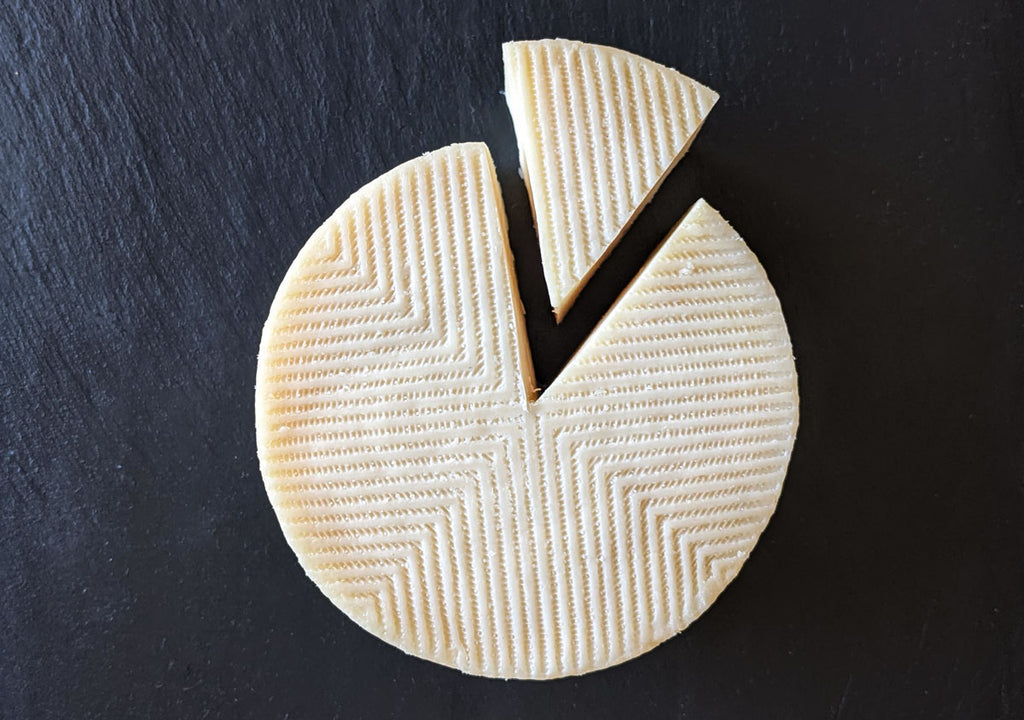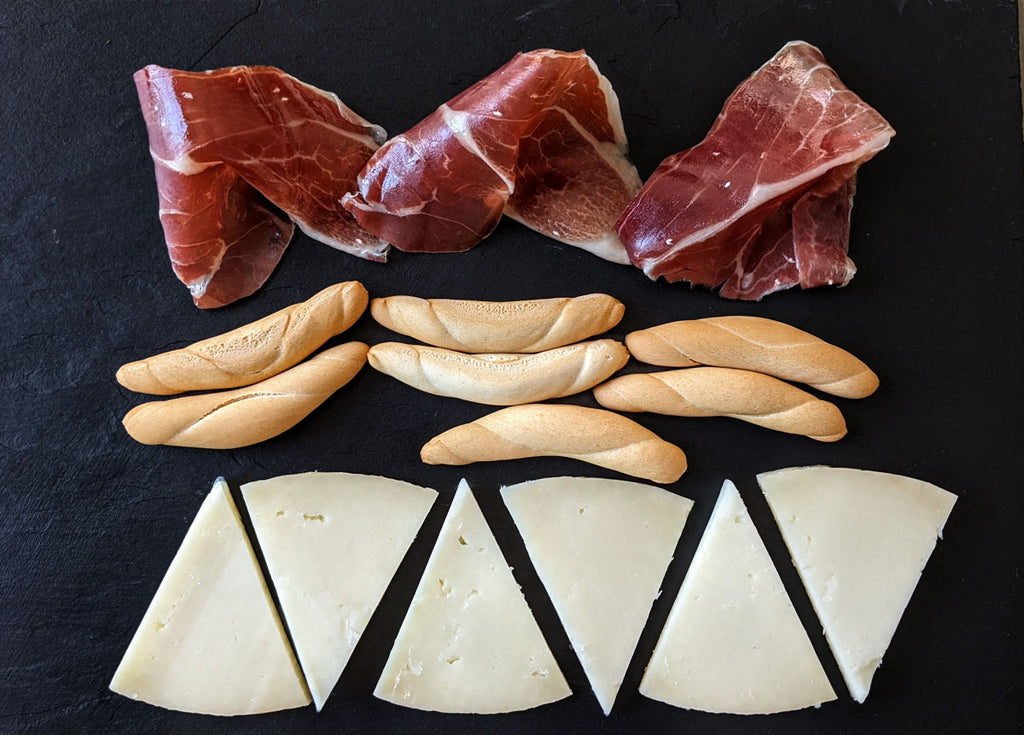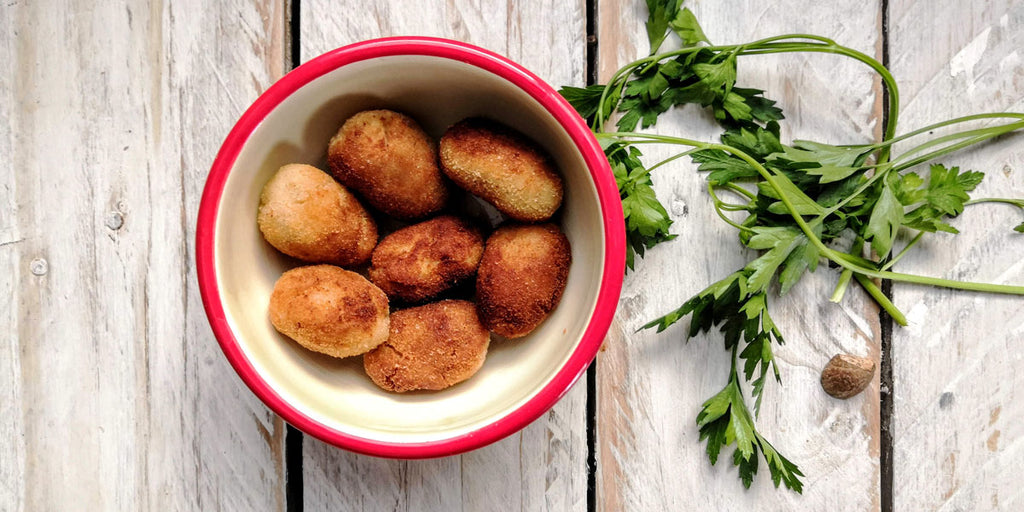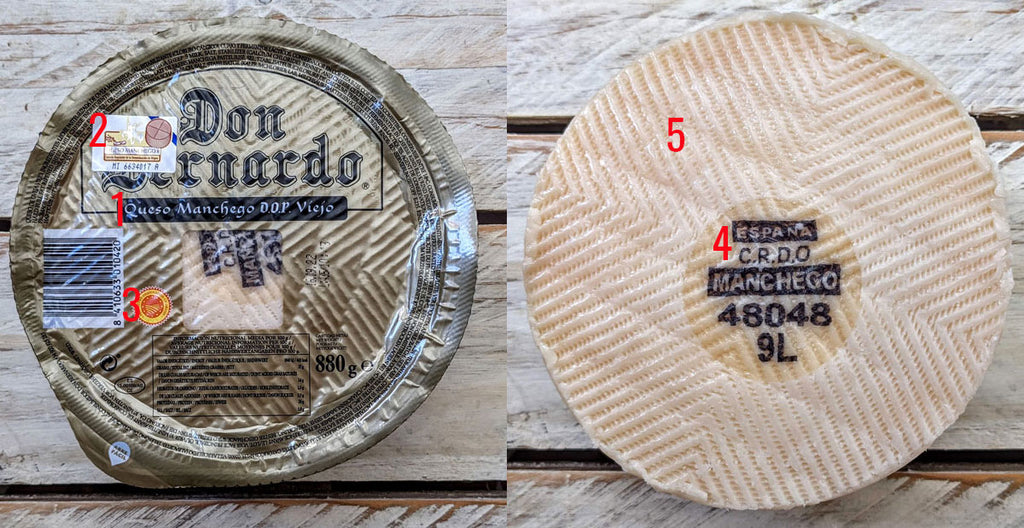
WHAT IS QUESO MANCHEGO?
MANCHEGO CHEESE
Queso Manchego is the most famous Spanish cheese. It comes from the La Mancha region and is made from the milk of the traditional Manchega breed of sheep. It is aged for at least 30 days and has a very distinct lasting taste, which takes on spicy notes in very mature cheeses.
Queso Manchego (pronounced [ˈkeso maɲˈtʃego]) is a mature cheese made from fresh or pasteurized sheep's milk coming from a special, traditional breed of sheep called Manchego, after which the cheese takes its name.
Manchego is an adjective denoting origin from the region of La Mancha, the central region of Spain made famous by Don Quixote. Queso Manchego is a protected designation of origin.

The upper side of queso Manchego has this typical pattern
HOW LONG DOES QUESO MANCHEGO AGE?
Queso Manchego is aged for at least 30 days if pasteurized milk is used and if the cheese weighs less than 1.5 kg. In any other case, it must mature for at least 60 days. As a rule, however, the cheese matures much longer - the maximum limit is set at 24 months.
WHAT ARE THE TYPES OF QUESO MANCHEGO?
QUESO MANCHEGO SEMICURADO
Medium-ripened cheese aged 60 to 150 days. It is creamy, softer, the taste is mild without any spicy notes.
QUESO MANCHEGO CURADO
Aged cheese aged 6 - 11 months. It's darker, harder. The taste is more persistent, more penetrating, with spicy notes.

Queso Manchego curado in the so-called cuña (cut) shape - the type of cheese must appear in the name
QUESO MANCHEGO AÑEJO (VIEJO OR RESERVA)
Extra aged cheese aged for more than 12 months. During ripening, the cheese loses almost all its water, which increases the intensity and persistence of the taste and aroma to the highest degree. The cheese has a pungent flavour and its colour is the darkest of all three types.

Queso Manchego Viejo (ie añejo)
HOW IS QUESO MANCHEGO MADE?
1. Fresh Sheep's Milk
Freshly gained sheep's milk from the special Manchega breed is cooled to a temperature of 4ºC.
2. Coagulation of milk
Coagulation is induced by natural rennet or other enzymes permitted by the standard of the umbrella organization of the trademark. The milk is heated in a container placed in a water bath to a temperature of 28 ºC to 32 ºC and allowed to curdle for 30-60 minutes.As soon as the first parts with the ideal consistency appear, they are subjected to a slow slicing process with a thin and perfectly sharpened knife.
3. Pressing the final shape
The chopped coagulated sheep's milk is filled into cylindrical molds with a typical relief, which imprints a typical pattern on the final product. Now the mass is pressed, depending on the size, for 1-6 hours.
4. Salting
The cheese of the cylindrical final shape is now salted either in a water bath or similar to dry-cured Spanish hams.
5. Aging
The aging process takes at least 30 days for cheeses smaller than 1.5 kg and at least 60 days for all others. The relative humidity must be between 75% and 90% and the temperature between 3ºC and 16ºC.
ORGANOLEPTIC PROPERTIES OF QUESO MANCHEGO

Comparison of cleaned and untreated rind with natural mold residues
Rind
-
Consistency
Hard.
-
Color
The surface is light yellow, or dark green nearly black if the mold that develops during maturation is not eliminated. -
Drawing
Typical drawing on the side and flat surface.
THE CHEESE ITSELF
-
Consistency
Firm and compact. -
Color
Depending on the degree of ripeness from white to ivory yellow -
Smell
A distinct and very persistent smell of sheep's milk with slightly sour and spicy notes. -
Taste
Slightly sour, intense and persistent. As the degree of ripening increases, spicy notes appear. -
Appearance
Characteristic uniform occurrence of so-called eyes (bubbles formed during ripening).
-
Texture
Low elasticity, cheese breaks easily. Individual grains appear in very mature cheeses.
The older the cheese, the more porous the consistency - in the picture the so-called "eyes" formed during the ripening process
HOW TO RECOGNIZE REAL QUESO MANCHEGO?
Real Queso Manchego can be recognized by these five signs
- Queso Manchego falls under the regional trademark whose formulation Queso Manchego DOP must be included in every cheese.
- An additional label on the top of the cheese with a unique numerical code and a simple drawing of Don Quixote on a horse.
- European yellow-red seal confirming the trademark of origin.
- Casein seal in the form of a large concentric ring on the underside of the cheese or a smaller seal (pictured). Here you will find again the confirmation of the trademark: DOP QUESO MANCHEGO and the numerical code.
- Both straight sides of the cheese are divided into quarters and the surface is rhythmic with parallel relief lines. The side is then drawn with rows of parallel and mutually perpendicular dashes between the rows.
IS THE QUESO MANCHEGO RIND EDIBLE?
Not always. Sometimes not, sometimes it is edible including the print of the so-called casein seal, but its consumption is still not recommended, because it serves as a natural casing for cheese and is often in contact with a not 100% hygienic environment. In addition, its consumption does not represent any great pleasure due to its consistency.
THE USE OF QUESO MANCHEGO IN COOKING
MANCHEGO ON ITS OWN
Cheese should be served at room temperature. Most often, queso Manchego is eaten on its own, cut either into 5-10mm thick rectangles or into strips or cubes. In restaurants, when ordering queso, i.e. cheese, it is often automatically understood that it is queso Manchego. It is often drizzled with olive oil on a cutting board or slate and topped with crispy picos. Quality queso Manchego is often combined on one plate with jamón ibérico.

Queso Manchego pairs well with jamón (most often ibérico) and is often served in that combination in Spain
BREAKFAST
Spanish breakfast would not be without some Queso Manchego. So if you order a tostada or pitufo (toasted bread) with queso (cheese), you will almost automatically get queso Manchego or at least a cheese of a similar type. The most common is una tostada con queso y aceite (toasted bread with cheese and oil), sometimes tomato puree is added. Usually only the bread is toasted, the cheese is not baked, although there is also a version with queso fundido (melted cheese), where the bread is toasted together with the cheese. The royal variant of a Spanish breakfast is the tostada con queso y jamón (toasted bread with cheese and serrano ham or ibérico jamón).

Typical breakfast - toasted bread with queso Manchego and olive oil
BAKED CHEESE
Baked tostas (toasts) are not part of breakfast in Spain. On the contrary, they are popular tapas or as main meals. The most popular are slices of white bread baked with a rich layer of queso Manchego and garnished with a freshly cut slices of jamón ibérico just before serving.
 Tostas with baked queso Manchego and jamón - simply delisious!
Tostas with baked queso Manchego and jamón - simply delisious!
RECIPES
Queso Manchego is sometimes, though not very often, used to prepare salads or cooked meals. You can most often find it in croquetas with Queso Manchego. A popular snack is the Spanish breaded cheese in the form of cubes that are fried and served with alioli.
 Bechamel croquettes are one of the most popular Spanish dishes - sometimes queso Manchego is added to the bechamel
Bechamel croquettes are one of the most popular Spanish dishes - sometimes queso Manchego is added to the bechamel
HOW TO STORE QUESO MANCHEGO?
The best is to keep the whole cheese in its original packaging. Cheese is always stored in the refrigerator, covered with any kind of lid that protects it from the odors of the refrigerator. If you buy a smaller vacuum-packed piece, ideally wrap it in cling film after opening to prevent it from drying out and oxidizing in the fridge.
CAN QUESO MANCHEGO BE FROZEN?
Yes, it can. It is necessary to clean and dry the cheese well, pack it ideally in a vacuum or at least in a closed clean container. Cheese should not be in the freezer for more than 6 months. Defrosting should be as slow as possible in the upper part of the refrigerator - expect about 8 hours. It is ideal to leave the cheese in the fridge for at least 2 days after defrosting before consumption, so that the bacteria are activated again and the cheese "wakes up" a bit.
TYPICAL COMPOSITION OF QUESO MANCHEGO
Pasteurized (or unpasteurized) milk from La Mancha sheep, milk ferments, stabilizer (calcium chloride), rennet, salt.


